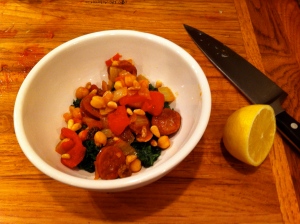I recently read two articles (links below) that have me thinking. Both of them are about this relatively new term, ‘food insecure’. Food insecure is the new term for hungry. One of the articles in National Geographic (NatG) describes many food insecure families as living outside of cities, middle class, white (over half), obese, working, driving cars that are often SUVs, owning cell phones and having multiple televisions. The NatG Article is quite interesting and I’d encourage all of you to read it. I’ve also included an article from Market Watch that explores what is a reasonable food budget and how the SNAP program might be modified to help make good food choices. Also a good read.
I read about several families courtesy of NatG who are considered food insecure. One family’s refrigerator was described as holding ‘takeout boxes and beverages but little fresh food’. Another family relies on, ‘premade food from grocery stores’ because ‘you can’t go all the way home and cook’. And this same mother feeds her children some hot fried chicken gizzards even though, ‘she knows she can’t afford to eat out and that fast food isn’t a healthy meal.’ But she had felt, ‘too stressed’ by her son’s nagging and by ‘how little money she has – not to give in.’
With each article I read about food and health it becomes more and more obvious exactly how culpable the government is in all of these problems. In this case it should be no surprise that a low-income family has sweetened drinks on hand because they are cheap. In fact, the #1 source of calories for low-income individuals is sodas, energy drinks and sports drinks. Why are these sugary drinks so cheap compared with say milk? It is no coincidence that corn, the main ingredient in sodas in the form of high fructose corn syrup is also awarded the highest government subsidy. Think about this for a moment. Our tax dollars are being used to make sodas less expensive than milk via government subsidies for corn. This encourages the poor to buy sodas instead of milk and our tax dollars subsidize that purchase. Then those unhealthy drinks contribute to obesity, diabetes and a slew of other health problems requiring health care that we subsidize.
One of the few things government should actually be doing for its citizens is protecting them from ‘evil corporations’ and yet corn subsidies continue as a result of government being in bed with corporate farming interests. It is making our poor sick and spending resources we don’t have. Big fail.
Another thing in common with many of the articles I read is condoning and/or excusing bad choices. Many of the families in the NatG article are consciously making bad nutrition and financial decisions. These people know better and admit it when interviewed. The NatG article points out that $10 of fast food (i.e. a mea)l can buy several days worth of fresh food. And yet because it is easy and convenient, these food insecure families choose fast food and premade food. The article points out that many middle class folks also opt for convenience over nutrition as if to justify this choice. Fair enough we all want convenience, but the difference is the middle class can afford it. Convenience is not a right. It is a luxury afforded by wealth.
Why are we allowing the poor who possibly don’t have the ability to make good choices and definitely don’t have the ability to care for themselves when they get sick to continue to fill themselves with sodas and fast food? Society should be ashamed that it is feeding our poor food that will kill them. We should only be allowing the poor to buy nutritious food with government assistance. Anything else is a betrayal. We are supposed to be helping these folks. We may be keeping them alive short term, but we are ensuring their lives will be brief and miserable as they succumb to debilitating health care problems resulting from poor nutrition.
People will immediately argue a few things. One is poor people should be able to make any choice they want. It is a free country! Yes, I agree as long as they aren’t using government assistance to do so. Hey, if you want to buy a candy bar or soda fine. Just don’t use your food stamps to do it because society wants you to live a long and healthy life.
Second, how could you possibly determine and enforce some sort of nutritional guideline? I agree this is very difficult and I don’t the government is up to the task as evidenced by the nutritional guidelines that have resulted in 1/3 of our population being obese. So simply don’t allow people on government assistance to buy anything with added sugar or high fructose corn syrup. Boom! It is simple, clear and easy to understand. If the food has added those sweeteners buy it with your own money. This won’t solve all the problems, but it will be a huge first step.
We owe it to low-income folks to help them make good choices. It is our responsibility to pass on what we know and help them avoid disaster. We need to help them learn to cook, break their sugar addiction and realize that eating healthy food is important. As a first step, simply not allowing them to make bad choices will have a wonderful positive impact on their lives. It is something we can be proud of.
http://www.nationalgeographic.com/foodfeatures/hunger/
http://www.marketwatch.com/story/why-america-is-losing-its-hunger-gamesand-how-it-can-win-2014-09-12
